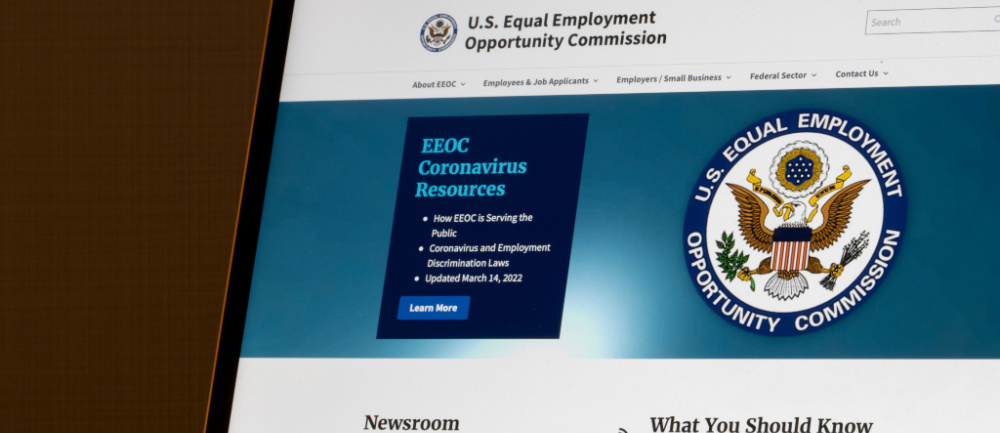U.S. Commissioner Keith Sonderling: Technology and talent acquisition
- 8 Min Read
HRD Connect spoke with Keith Sonderling, Commissioner at U.S. Equal Employment Opportunity Commission (EEOC), on creating a level playing field for employees and the role of technology in talent acquisition and management.
- Author: Keith Sonderling
- Date published: Oct 26, 2022
- Categories

 What’s been the biggest driver in creating equal and equitable employment opportunities?
What’s been the biggest driver in creating equal and equitable employment opportunities?
Most employers want to comply with the law; however, they sometimes just need guidance and tools to assist them. This is why guidance from the EEOC helps us meet our mission to prevent discrimination and advance equal opportunity for all in the workplace.
For example, employees and employers recognized how valuable these resources are during the global COVID-19 pandemic. From the beginning of the pandemic, the EEOC provided timely and meaningful guidance in answering novel questions the workforce was currently facing. Essentially, there was one less thing for employers to worry about during the global pandemic, enabling them to protect their employees during challenging times lawfully.
Guidance involving other current issues such as caregiver rights in the workplace, discrimination against veterans, and guidance on the opioid crisis and the workplace. Providing timely and meaningful guidance – in plain English – has helped a multitude of employers to understand their legal obligations and avoid discriminating against applicants and employees. It has also helped equip workers to know their legal rights, know when they may have been subjected to discrimination, and know how they can best respond.
_____
What ethical considerations should HR make when considering AI in recruitment?
Carefully designed and properly used, I believe that AI has the potential to advance diversity, inclusion, and accessibility in the workplace by mitigating the risk of unlawful discrimination.
However, poorly designed and carelessly implemented, AI can discriminate on a scale and magnitude far greater than any one person. Therefore, HR professionals using AI must ensure that the data AI correlates, and the outcomes are free from bias. It is important to build trust in the use of AI for recruitment by promoting transparency, explainability, reliability, and integrity.
Accordingly, HR must evaluate whether its use of AI supports the employer’s business objectives while taking steps to mitigate risks with the technology. Ensuring HR professionals have the tools to do so has been my highest priority.
_____
When is it important to retain the human touch in talent acquisition, and why?
Companies should maintain human involvement throughout the entire talent acquisition process to ensure TA strategies are performing as expected, to minimize bias, and to prevent unlawful discrimination. For example, HR professionals should still review job advertisements to identify possible bias or discrimination.
As each and every word in a job description may have unintended consequences of dissuading diverse candidates from applying (often based upon sex), HR professionals must ask themselves: “Is this requirement truly job-related and necessary?” When resumes are received, next they must also be involved in ensuring that applicants with a disability feel comfortable and will not be penalized for requesting accommodation. Lacking the “human touch” will only increase the risk of discrimination.
_____
What are the main drawbacks to AI in recruitment?
AI’s reliance on hard data creates the potential to eliminate discrimination by removing human bias from decision-making. When AI is designed in a clear and explainable way, it eliminates one of the biggest challenges to effective human resource management: human bias. But at the same time, the apparently objective nature of algorithmic decision-making can result in technological bias on the part of the user. That is that the AI will always get it right.
I fear that users of AI in HR may lose sight of the fact that AI is self-reinforcing and requires close monitoring. I have been urging HR professionals not to adopt a “set-it-and-forget-it” approach to HR technologies because inaccurate, incomplete, or unrepresentative data will only amplify rather than minimize bias in decision-making.
In my opinion, over-reliance, if not blind trust, that the robots will always get it right may lead to unintended discrimination. While AI is becoming a mainstream technology in the workplace, discrimination by algorithm must not. I will continue to be a vocal advocate for the lawful and ethical use of HR technology, while providing employers with best practices to prevent discrimination by algorithm.
_____
What steps can HR leaders take to ensure equal employment opportunities and prevent discrimination?
A commitment to ensuring opportunity and preventing workplace discrimination starts at the top. From the company’s board, C- suite, to all of its management — preventing workplace discrimination and ensuring equal opportunity must be engrained in the culture. Not only will this assist HR leaders in implementing such programs, but it more importantly builds trust with employees.
HR leaders should clearly communicate to employees that discrimination of any kind will simply not be tolerated. Establishing an effective complaint process, providing training to their managers and employees, and taking immediate and appropriate action when an employee complains, will help mitigate discrimination. HR leaders should strive to create an environment in which employees feel free to raise concerns and are confident that those concerns will be addressed. Five core principles for HR leaders should be:
- Committed and engaged leadership;
- Consistent and demonstrated accountability;
- Strong and comprehensive EEO policies;
- Trusted and accessible complaint procedures; and
- Regular, interactive training tailored to the audience and the organization.
_____
Which are the most common employment areas for discrimination to occur?
It is important to remember that the laws the EEOC administers and enforces, not only apply to employees but applicants as well. Each year, the EEOC receives over 60,000 charges of discrimination often alleging discrimination based on several protected characteristics. For the past 13 years, retaliation has been the most common claim filed with the agency.
In 2021, 56% of all charges alleged retaliation. Retaliation claims are high because they are often secondary to a different underlying discriminatory claim, for example, sexual harassment. Victims of discrimination may face retaliation after they complain of or oppose discriminatory actions.
After retaliation, the second most common claim nationwide is disability discrimination. Over the last two decades, the percentage of charges alleging disability discrimination has doubled. The third most common claim of discrimination is harassment, followed by discrimination based on race, sex, age, and national origin.
_____
How can companies improve candidate engagement and/or onboarding with workforce data?
AI can help employers equally consider all candidates for opportunities. It can identify a candidate’s current, adjacent, and potential skills and suggest opportunities the applicant would have never considered. AI can identify the best candidates based, not only on their merit, but on their potential, all while stripping out human bias. Employers can use AI tools and data analytics to support more fair and unbiased decisions, thereby not only improving their experience as a candidate but providing them with career satisfaction.
Further, during the onboarding process, AI can streamline the completion of onboarding paperwork while highlighting beneficial resources and answering common questions for new employees. This will help companies put forth a better first impression that conveys organization and support during such a critical period for new employees. Also, data analysis can foster improved employee experiences throughout the employee lifecycle by recognizing signs of disengagement and fairly allocating workloads to avoid burnout. Properly using this data will support the efforts of companies to retain quality employees and will prevent employee attrition.
However, deciding to entrust algorithms with people’s livelihoods is a complex and important matter. Using AI to make decisions ordinarily made by HR professionals, especially related to candidate experience and employee onboarding, can have significant legal ramifications, especially for candidates and employees with disabilities. HR leaders should exercise caution when deciding when and whether to hand these matters over to algorithms.
_____
How have US employment opportunities changed in the time since you joined the Commission?
Since I joined the Commission in September 2020, the pandemic has changed all aspects of work and the employee experience. However, it has not changed the fundamental rights of employees to be protected from discrimination, whether in-person or now remote. The additional opportunities for hybrid and remote work arrangements continue to open the door for job seekers to pursue opportunities across the country and the world.
The rapid implementation of emerging technologies has improved accessibility for individuals with disabilities. The increase in flexibility has allowed many employees to balance family and professional responsibilities. It has also encouraged many, especially older workers, workers with a disability, and parents who left the workforce, to re-enter at their own pace. HR departments are rightfully critical to ensuring the renewed focus on diversity, inclusion, and accessibility, through skills-based hiring which provides greater employment opportunities.
_______________
Keith E. Sonderling was confirmed by the U.S. Senate, with a bipartisan vote, to be a Commissioner on the U.S. Equal Employment Opportunity Commission (EEOC) in 2020. Until January of 2021, he served as the Commission’s Vice-Chair. His term expires July of 2024.
Prior to his confirmation to the EEOC, Commissioner Sonderling served as the Acting and Deputy Administrator of the Wage and Hour Division at the U.S. Department of Labor. Before joining the Department of Labor in 2017, Commissioner Sonderling practiced Labor and Employment law in Florida. Commissioner Sonderling also serves as a Professional Lecturer in the Law at The George Washington University Law School, teaching employment discrimination.

